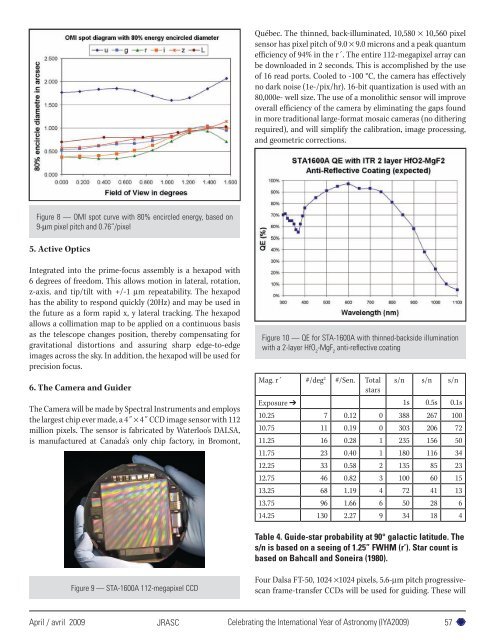Moment
insidethisissue - The Royal Astronomical Society of Canada
insidethisissue - The Royal Astronomical Society of Canada
You also want an ePaper? Increase the reach of your titles
YUMPU automatically turns print PDFs into web optimized ePapers that Google loves.
Québec. The thinned, back-illuminated, 10,580 × 10,560 pixelsensor has pixel pitch of 9.0 × 9.0 microns and a peak quantumefficiency of 94% in the r´. The entire 112-megapixel array canbe downloaded in 2 seconds. This is accomplished by the useof 16 read ports. Cooled to -100 °C, the camera has effectivelyno dark noise (1e-/pix/hr). 16-bit quantization is used with an80,000e- well size. The use of a monolithic sensor will improveoverall efficiency of the camera by eliminating the gaps foundin more traditional large-format mosaic cameras (no ditheringrequired), and will simplify the calibration, image processing,and geometric corrections.Figure 8 — OMI spot curve with 80% encircled energy, based on9-µm pixel pitch and 0.76”/pixel5. Active OpticsIntegrated into the prime-focus assembly is a hexapod with6 degrees of freedom. This allows motion in lateral, rotation,z-axis, and tip/tilt with +/-1 µm repeatability. The hexapodhas the ability to respond quickly (20Hz) and may be used inthe future as a form rapid x, y lateral tracking. The hexapodallows a collimation map to be applied on a continuous basisas the telescope changes position, thereby compensating forgravitational distortions and assuring sharp edge-to-edgeimages across the sky. In addition, the hexapod will be used forprecision focus.6. The Camera and GuiderThe Camera will be made by Spectral Instruments and employsthe largest chip ever made, a 4˝ × 4˝ CCD image sensor with 112million pixels. The sensor is fabricated by Waterloo’s DALSA,is manufactured at Canada’s only chip factory, in Bromont,Figure 10 — QE for STA-1600A with thinned-backside illuminationwith a 2-layer HfO 2-MgF 2anti-reflective coatingMag. r´ #/deg 2 #/Sen. Totalstarss/n s/n s/nExposure ➔ 1s 0.5s 0.1s10.25 7 0.12 0 388 267 10010.75 11 0.19 0 303 206 7211.25 16 0.28 1 235 156 5011.75 23 0.40 1 180 116 3412.25 33 0.58 2 135 85 2312.75 46 0.82 3 100 60 1513.25 68 1.19 4 72 41 1313.75 96 1.66 6 50 28 614.25 130 2.27 9 34 18 4Table 4. Guide-star probability at 90° galactic latitude. Thes/n is based on a seeing of 1.25” FWHM (r’). Star count isbased on Bahcall and Soneira (1980).Figure 9 — STA-1600A 112-megapixel CCDFour Dalsa FT-50, 1024 ×1024 pixels, 5.6-µm pitch progressivescanframe-transfer CCDs will be used for guiding. These willApril / avril 2009JRASCCelebrating the International Year of Astronomy (IYA2009)57
















